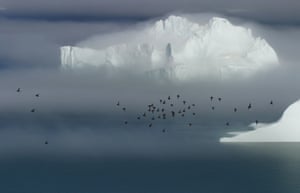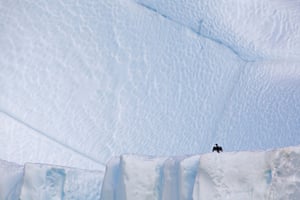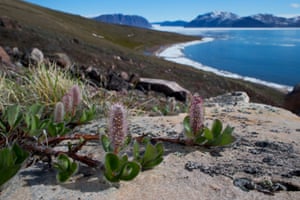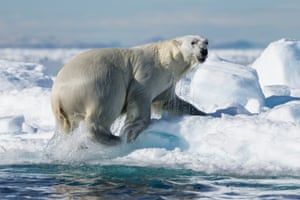Greenland’s ice melt has been adopted by the world as a bellwether
for climate crisis, but the impact on biodiversity has been overlooked.
At an ice station on a remote Arctic glacier, scientists are looking to
the smallest of life forms to predict the pace of species extinction
by Dan McDougall in Sermilik, 65˚40’ N and 38˚10’ W; photographs by Carsten Egevang
by Dan McDougall in Sermilik, 65˚40’ N and 38˚10’ W; photographs by Carsten Egevang
Behind the remote research huts of Sermilik ice station, a vast sheet
of ice stretches north for 1,480 miles, spanning an area three times
the size of France.
It is holding 10% of the world’s freshwater, water that has been frozen solid for millions of years. It’s glacier calving season in the south-eastern reaches of Greenland, and the adjacent channel is full of the thunderous roars and cracks of a flotilla of icebergs breaking apart.
Across a narrow granite ravine separating the visitors’ hut from the main living quarters of the 40-year-old international scientists’ base, lab machines click and whirr through the night.
The day’s samples – water, air, carbon, algae – spin
frantically around curious-looking aluminium discs. Melting ice drips
slowly into assorted beakers. Struggling to adjust to the midnight sun, a
team of international research scientists from Aarhus University and
Germany’s national research centre for solid earth sciences peer into
microscopes at clues to the planet’s future. These are samples of
glacial past and present, retrieved from the belly of the Mittivakkat
glacier, which is in mortal retreat on the plateau above. To understand
our origins, scientists look to the stars. To understand our eventual
demise, the glacier is ground zero.It is holding 10% of the world’s freshwater, water that has been frozen solid for millions of years. It’s glacier calving season in the south-eastern reaches of Greenland, and the adjacent channel is full of the thunderous roars and cracks of a flotilla of icebergs breaking apart.
Across a narrow granite ravine separating the visitors’ hut from the main living quarters of the 40-year-old international scientists’ base, lab machines click and whirr through the night.
Far from being barren places, glaciers represent more than 10% of our landmass and are teeming with biodiversity. They are spawning and breeding places not just for the familiar species like whales, arctic hares and foxes, polar bears, seals and muskoxen but also for bacteria, fungi and algae that have a vital role in the planet’s biodiversity. This team of microbiologists is attempting to decode the lives of these hidden creatures and their links to the ice melts across the polar caps. Algae blooms, these scientists say, are turning sun-reflecting glaciers into sun-absorbing hotspots.

Archive photographs in Greenland’s capital, Nuuk, show that the Mittivakkat glacier’s vast icy mouth opened out to the Arctic Ocean as recently as the 1950s. But to reach its heart in 2019 is a hike many miles inland, crossing rocky terrain in entirely unexpected 23-degree heat. Lichen and unseasonal arctic flowers line the route, as do thirsty mosquitoes, who feast on the moisture of human eyeballs, relenting only at the ice line.
Flying over a glacier by helicopter it’s easy to dismiss the landscape as devoid of life, but for the seven scientists at Sermilik hiking over the ice, it is a source of constant fascination for animal and plant life.
Alexandre Anesio is a professor in Arctic biogeochemistry from Aarhus University. A charismatic Brazilian, he has a rifle slung over his shoulders – one of four armed researchers, all on constant vigil for the polar bears who stalk the coastline here. He is also probably the worst shot. His young doctoral students, Eva Doting and Laura Halbach, look more keen-eyed, having spent the last month preparing by shooting polar bear targets at a rifle range in Copenhagen.
On the Guardian’s first evening, over supper, Anesio explains with earnest patience that snow isn’t universally white. Some of the last snow to lie on the surface of the earth, long after the human race is gone, might even be red. Not blood-red – more a watermelon hue.
He also talks about how, in the end, the fate of our glaciers, sea-level rises and biodiversity loss, will not only come down to the excesses of the industrial age and our unbridled consumer life, but also to the influence of algae.
The sticky green residue familiar from childhood tadpole ponds, as it turns out, could be a microscopic bellwether for this age of extinction.
Each year, high on Greenland’s glaciers, algae perform a remarkable migration. After spending winter deep in the snowpack as dormant cysts, they awake in spring and swim through snowmelt, dividing and photosynthesising along the route.
When they reach the surface, the algae turn black, dark green and crimson – colours that come from astaxanthin, a molecular cousin of the chemical that makes sweet potato orange.
The algae produce it as a sunscreen, as it absorbs UV light. As a consequence the humble algae dramatically reduce the amount of sunlight reflected by Greenland’s glaciers and increase the sunlight they absorb, darkening the snow and ice.
Most concerning for the researchers out on the glacier is the fact the algae that live on the ice surface in summer are increasingly dark brown, leading them to absorb more sunlight and exacerbate melting.

The team is now aiming to understand the mechanisms behind the algal growth, and how the organisms have adapted to live on the ice. The key question is whether the algae will grow and darken other areas of the ice sheet as the climate gets warmer. If this happens, which is what the team here in Sermilik suspect, it will mean up to 30% faster melting of the ice sheet than existing models are predicting.
“In 2019 our glaciers and ice sheets [are] already being darkened by dust, soot, and ash from our industrial world, which provides the perfect home for algae to flourish,” Anesio says. “As the organisms reproduce, they melt even more snow, which in turn allows them to proliferate again. So it’s like a cycle. A very bad one.”
As algae spread, the effect will be compounded, leading to even more melting.
Benning, of the German Research Centre for Geosciences or GFZ in Potsdam, was previously part of the Black and Bloom project to understand how and why the Greenland ice sheet is melting. She says algae-discoloured snow isn’t just an Arctic phenomenon.
“It’s a global occurrence,” she says. “This is increasingly a problem in the Arctic, Alpine and Himalayan glaciers. Blooms of red snow and brown ice are turning up in Antarctica also. What we hope to do is spread our research out further because we believe this is a significant factor in ice melt. This is why we are back here in Greenland but we believe the work also needs to be done elsewhere.”

The sound of a city block-sized portion of ice as it separates from Greenland’s ice shelf is unique. A violent sonic boom is followed by an echoing machine-gun style “ak-ak-ak-ak” as the iceberg turns on its axis, before surrendering to the ocean with an eerie silence. There is a sadness to it.
On one single day last month, Nasa’s Oceans Melting Greenland project announced that Greenland’s ice sheet had suffered its most substantial single-day volume loss on record, sending an estimated 12.5bn tonnes of ice pouring into the Arctic Ocean – a body of water that could cover the whole of England in five inches of water. If the Greenland ice sheet disappeared tomorrow, sea levels around the world would rise by seven metres and life, as we know it, would come to an end.
Glaciers matter. And they are in universal retreat. By 2100 Alpine summits may have lost around nine-tenths of the ice that covered them in 2003. In western Canada, somewhere between 60% and 80% of the ice measured in 2005 will have disappeared and flowed into the sea. In South America, the glaciers of Bolivia have lost almost half their mass in the last 50 years.
Sermilik’s scientists argue for serious thinking and funding to understand glacier loss. For Anesio, who left his job at Bristol University, transferring to Denmark because of the potential impact of Brexit on his research, science has to be “something collaborative”.
“There is no question that the data we are seeing is concerning,” he says. “One of the latest predictions is that there is a 10% chance for sea levels to rise by two metres in 2100. So maybe some people think 10% is not a great chance – but I don’t think I would cross the street if I had a 10% chance [of being] hit by a truck.
“Our job as scientists is to create more accurate models and add to our global understanding of the climate crisis so that it can be used for politicians to take action – we hope, a little bit faster than is happening now.”
As glaciers retreat from India to Greenland, biodiversity is being lost. According to the UN one million species face extinction due to human influence. Such a collapse in biodiversity would wreak havoc on the interconnected ecosystems of the planet, putting humans at risk by compromising food sources, fouling clean water and air, and eroding defences against extreme weather such as hurricanes and floods.
As Greenland’s ice melt has been adopted by the world as a global bellwether for climate crisis, less focus is being placed on the impact on biodiversity.
This ice sheet is not just being melted by algae bloom and from above by warmer air temperatures. Arctic waters are reaching record high temperatures and warmer water is lapping against these great glaciers.

For Greenland, one of the least densely populated countries in the world, the impact will be felt on land by the nation’s flowers, plants, bushes and heather, its polar bears, caribous, arctic hares, foxes and wolves and at sea by narwhals, seals, bowhead whales and the large variety of unique sea birds.
This is biodiversity that actually faces few direct pressures from human activities – the major threat is glacial melt and climate crisis. The shrinking of the sea ice area is already having a significant impact on marine ecosystems. It’s an essential habitat and breeding ground for many species, ranging from micro-algae to marine mammals.
This is now a hungry time for polar bears struggling to access the sea ice to hunt for seals. An estimated 3,500 of the bears stalk the coastline of Greenland and at Sermilik, stories are swapped of close encounters with the animals.

For the younger members of the Sermilik team, the bleakest conversation held at the ice station is around the plastic being discovered.
“We are finding plastics in the atmosphere at the centre of Greenland’s ice sheet,” says Dr James Bradley, assistant professor at the Queen Mary University of London. “Millions of tonnes of plastic are discarded into the environment every year and are broken down into small particles and fibres that do not biodegrade. These particles, known as microplastics, have now been found everywhere from high mountains to deep oceans and can carry toxic chemicals and harmful microbes. Microplastics are tiny pieces of plastic waste. Their presence in oceans and waterways has received a great deal of scientific and media attention in recent years, but our growing concern is their presence in the atmosphere.”

He says that he also has hope, “because I can see a new movement in the young generation that cares. I think that everyone individually can contribute, by pressing politicians, but also by making their contribution in terms of the reduction of CO2.”
Leaving the ice station by boat, negotiating the same narrow channel of icebergs that brought us here, we pass over the shattered remnants of a glacier and stop to scoop a 1,000-year-old chunk of ice from the water. These lumps of ice can only meet one path, drifting out into the Arctic sea at the mercy of winds and warm currents until they break apart into the ocean.
Days later, further north of the island, a local ship’s captain summed things up with his Greenlandic dark humour. “That noise you hear out there. The fizzing and cracking,” he tells me, cupping his ear to the wind for dramatic effect as his old wooden ship passes through a fjord filled with decaying mountains of ice.
“That noise is the end of the world.”

No comments:
Post a Comment